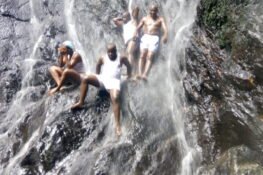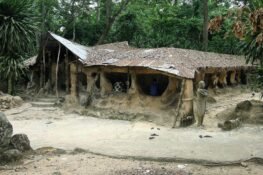Kaduna state is one of the prominent states that make up Northern Nigeria and is often referred to as the capital of the region as many prominent northerners see the state as a home.
The word Kaduna is said to be a corruption of a Gbagyi word/name for a river. Another version of the etymology of the name is a narrative linked to the Hausa word for crocodile – but this is contested by the Gbagyi people known to have lived in the area for centuries.
It is, therefore, indicative that the name, Kaduna, was taken up by Lord Frederick Lugard and his colonial colleagues when they moved the capital of the then Northern Region from Zungeru to Kaduna in 1916.
This move of the colonial office to Kaduna started in 1912-1918/20 with the initial effort having been made in 1902 from Jebba to Zungeru.
At the start of British colonial rule in northern Nigeria, the people who live in the area became ‘Northern Nigerians’- a construct which continues even today.
By 1967 these people groups again were carved into ‘North Central State’; this was the case until 1975 that ‘Kaduna State’ was formerly created by the then military leader, Gen. Murtala Mohammed, with all distinct identities amalgamated into one state without a referendum. The state hence is the successor of the old Northern Region of Nigeria, which had its capital at Kaduna which is now the state capital to about 6.3 million people (Nigerian census figure, 2006).
In 1967, the old Northern Region was divided into six states in the north, leaving Kaduna as the capital of North-Central State, whose name was changed to Kaduna State in 1976.
Meanwhile, Kaduna State was further divided in 1987, creating Katsina State. Under the governance of Kaduna are the ancient cities of Zaria, Kafanchan, and Nok, the area where Africa’s earliest civilization is recorded to have been excavated.
The history behind the state has become a pull for Nigerians and foreigners alike to visit the numerous attractions in the state.
Here are major destinations that tourists to the state cannot afford to miss:
Kajuru Castle: An unexpected mountain resort
Kajuru Castle is a remote piece of wilderness most Nigerians have never heard of – and only a few have been there. Designed typically European and similar to what is seen on Western TV or publications.
Kajuru Castle is a luxury resort built in early medieval style at Kajuru village, Kaduna State in 1978 by a German expatriate, who lived in Kaduna at the time. It took five years to build complete with turrets, armoury and dungeon,
Located at about 45 kilometres from Kaduna on the Southern Kachia road is the village of Kajuru. If one takes to the road at the right, in the centre of the town and drives past the Local Government Headquarters, for about 5-7 kilometres, one will see on the left a strange sight on a mountain ridge; a European castle in Africa!
Indeed, the first timer may assume he is imagining things or his eyes are probably playing games on him, but this is for real.
The breathtaking architectural masterpiece is a tourist wonder of sorts. The style is very European and clearly German with a baronial hall, complete with suits of armour.
Being surrounded on all sides by mountains and hills give the castle a setting and an ambience that offers a ‘Home away from Home’ experience for visitors, who need the sort of serenity to refresh, to reflect or simply to get away from a busy schedule.
The castle’s remote location and hilly topography is ideal for a hike. In the castle, there are bedrooms looking like dungeons and several towers with crenulated walls. The rooms are spread across the castle’s three floors, inside the structure to the left, which is the one that has the turrets at the top.
On the right is the cylindrical castle building, also with its own apartments and rooms which include four dungeon-like bedrooms, a master suite (referred to as the Landlord’s residence and a baronial hall with a complement of armour.
On the rooftop, there is a set of tables and chairs that can sit no less than 10 guests at a time. There is also a garden but the most attractive part of the facility is the open courtyard with the large pool and pool chairs, plus a barbecue area complete with an outdoor oven.
The castle is made up of a magnificent large stainless steel swimming pool and well-equipped kitchens (it is self-catering for those who can gain entry).
It is a Private Property, and entry to this place is not very easy. Beware there are also crocodiles in the moat protecting the castle gates! The road up to the castle requires a 4×4 vehicle.
Kaduna Museum
The Kaduna National Museum, one of the many historical monuments the city inherited for being the capital of the defunct Northern Region.
Established in 1975, the museum had witnessed some remarkable improvements in the last few years. Now, the old dilapidated building has been pulled down and a new one is being built, but the progress of work is slow.
For any tourist who wants to see ethnographic and archaeological artefacts in their finest collections, a visit to the Kaduna National Museum and Monument will provide that opportunity.
The museum has in its collections both Archaeological and Ethnographic materials ranging from terracotta figurines of human and animals from the famous Nok culture area dated to about 2,500 years ago, as well as artworks and crafts of both prehistoric and contemporary societies.
Also found in the museum are building structures constructed with the Hausa traditional architecture of mud and thatch. The museum is a fascinating building recommended to Tourists. The National Museum in Kaduna used to be a beehive of activities, attracting visitors from far and near, including foreigners.
The Lugard Foot Bridge
The Lugard Footbridge is a pedestrian bridge located in Kaduna, the capital of Kaduna State, Nigeria. The footbridge is presently located in the General Hassan Katsina Park, Kaduna. It was built by Sir Frederick Lugard in 1904, and it was named after him.
The bridge served as a link between his residence and other quarters of colonial Zungeru over river Kaduna. Shortly after the amalgamation of Northern and Southern protectorates, Kaduna was made Northern Headquarters in preference over Jebba or Lokoja in 1920 by Lord Lugard.
The Zungeru Footbridge was moved to Gamji Gate Kaduna in 1954 and declared Historic Monument on 16th February 1956 by Federal Department of Antiquities now National Commission For Museums and Monument under Antiquity Ordinance of 1953.
Emir of Zazzau Palace
The Palace of the Emir of Zazzau is situated within the Walls of the ancient city of Zaria. Made of mud, the principal building agent in the 19th century when it was built, the designs and features are typical of the traditional Habe architecture.
A visit to Kaduna state o Zaria is not complete without a visit to the Emir of Zazzau’s palace. Some of the things you can do on a tour are a visit around the main courtyard and the anteroom as well as the corridor leading to the Emir’s main living area. You would also get to learn about the history of the Zazzau Emirate as well as the exploits of its most famous ruler, Queen Amina.
Kamuku National Park
This is what can be called Nigeria best-kept secret. It was established in 1936 under the name Native Authority Forest Reserve of Birnin Gwari. It was designated under the northern Nigerian Government.
In May 1999, the Kamuku National Park was upgraded from а state Game Reserve to а National Park.
Tourists on game viewing can catch some of these elephants, roan antelopes, duikers, hartebeest, baboons, warthog, bushbuck, patas monkeys, and green monkeys.
There are at least 177 species of birds, including migrants and residents.
The park is important for species such as the secretary bird (Sagittarius serpentarius), Denham’s bustard (Neotis denhami) and the Abyssinian ground-hornbill (Bucorvus abyssinicus) which are rare in other parts of Nigeria.
The Nok Village
Nok village is located in the Kaduna State of central Nigeria, 160 kilometres northeast of Baro. The Nok civilization was discovered in 1928 due to tin mining that was happening in the area and earned its name due to the Nok civilization that used to inhabit the area from around 500 BC.
Mysteriously the people of the village vanished in about 200 AD. These people were known for their extremely advanced social system and were the earliest producers of life-sized Terracotta in the Sub-Sahara.
Hugely historical, archaeologists have found human skeletons, stone tools and rock paintings around this area, not to mention the main act.
The inhabitants of what is now called Nok Village, were known to make some of the oldest and culturally intriguing sculptures found in Africa. This led to discoveries that the ancient culture of Nok has been around for some 2500 years.
When strolling through the village your senses will be delighted to rediscover an amazing group of people culturally and socially.
Not much is known about the purposes of these popular sculptures but some theories have suggested they were used as charms to prevent crop failure, illness and infertility.
You’ll really feel as if you’ve had the best history lesson of your life. Weapons of war, terra cotta heads of man and animals are abundant as you realize your dream is actually a reality. Nok village is a great place to take your family and be able to learn together about our world’s amazing past.
With additional reports from https://en.wikipedia.org, www.tolet.com.ng and travel.jumia.com






